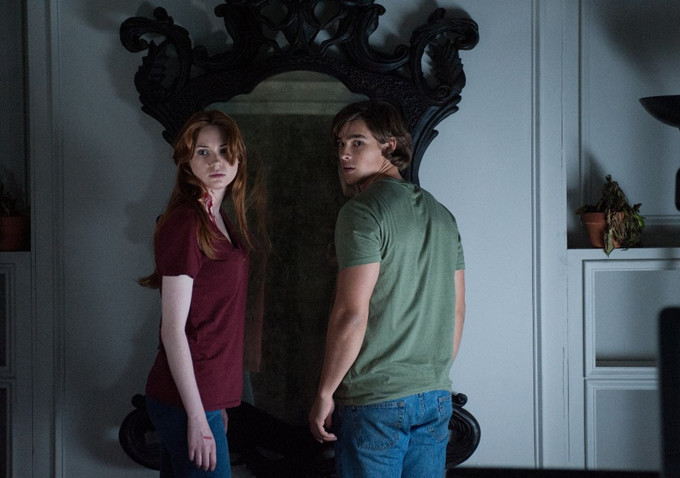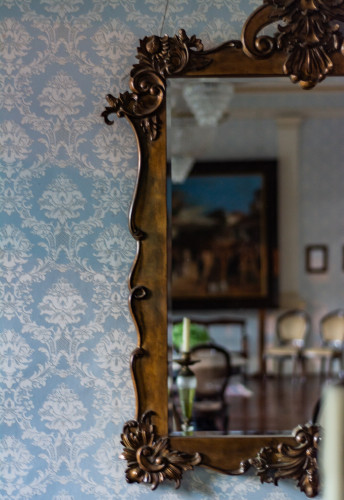Mirrors are thought to be portals to another world—some believe this is another dimension, but those who believe in ghosts believe it is a portal to the other side. Many cultures still hold on to their superstitions that exist concerning mirrors, ghosts, souls, and death. In cultures that are still considered primitive by some, there is the belief that mirrors reflect the soul and that they must be avoided in order to prevent the soul from being lost—not unlike the belief that taking photographs of a person will also capture their soul. Russian folklore dictates that mirrors are an invention of the Devil due to their ability to draw the soul out of the body. This also makes sense that there are superstitions that are still held within some places of the world that all shiny and reflective surfaces, mirror or otherwise, must be covered in a house after a death. Their belief requires covering mirrors after death to prevent souls from the living being taken by those who have recently departed the mortal plane. Depending on the lore of the culture, the mirrors may actually be covered for a variety of reasons—it could be a corpse looking back at you over your shoulder, at which time the soul of the dead will have no rest.
It is incredibly unlucky for those who are ill to see their reflections, it puts them at risk of dying, so cultures that believe the soul is vulnerable during times of illness often remove the mirror entirely from where the sick person is residing. More bad luck comes when looking into a mirror in a dark room by candlelight, during which event the observer will see ghosts, the Devil or other paranormal phenomena, such as Bloody Mary. Aside from the bad luck associated with staring into mirrors that seem to be widespread within many cultures, there is also the ancient cultural relevance that should be mentioned. In Greek myth, the tale of Narcissus warns against becoming so entranced with his own reflected image in a pond that he fell into the water and drowned—then again, the Greeks believed that even dreaming of your own reflection was an omen that foretold death. Suffice it to say that there is a lot of nasty lore when it comes to mirrors and this article can only explore a few of them.
The Myrtles Plantation: The Most Haunted House in the World
The folklore of mirrors isn’t just some abstract idea that appears in stories, there are actually ghost stories about places where it is reported that haunted mirrors are still on view to the public. In St. Francisville, Louisiana, the Myrtles Plantation plays host to several apparitions, most notably the spirits of Sara Woodruff and her two children, which were allegedly poisoned by a slave named Chloe—she apparently had an affair with Sara’s husband and committed this crime of passion against his family. These spirits appear in a mirror that hangs in the location of the original mirror, which over the years has had to be replaced several times, it’s said that Sara’s face, children’s fingerprints, and claw marks appear within the reflection of the mirror. The mirror was not covered during the wake that followed their deaths, a practice during the 19th century in the Southern United States, not following the tradition therefore trapped their souls within the home, where they can only appear as reflections.
The Truth Behind the Bloody Mary Legend
Bloody Mary, the haunting presence that inspired the movie Candyman (1992)–set to be remade and released in 2020–is based on the legend of a woman who appears in a mirror after being summoned. The origin of Bloody Mary varies widely, the most popular of versions is that of Mary Worth, a witch executed during the Salem Witch Trials. Other versions claim she was a hitchhiker who was badly mutilated and then died following a dreadful car crash, while still others suggest she was a child murderer—this particular version can’t be sure whether she just murdered children in general or if it was her own child. Finally, another famous variation suggests that Bloody Mary was actually royalty, but there tends to be another disagreement on which royal Mary she happened to be. Was she Mary Tudor, Queen of France, or Mary I, the first Queen Regnant of England? Regardless of the origin of the story, it remains a popular game among teens and preteens during slumber parties, which shows how ingrained paranormal superstition is within western societies.
These games also have variations, as is the case when the tradition is passed on orally, but whether her name is chanted three times or thirteen times, the room must be darkened, with backlighting by candles or flashlights. Will Bloody Mary tell you who your future spouse is, how many children you’ll have, or if you’ll die before marriage? If you’re brave enough to find out, you’ll face the possibility of being killed, driven insane, or being taken by the mirror.

Films that are based on Bloody Mary
- Agent 077: Mission Bloody Mary (1965)
- Candyman (1992)
- Urban Legends: Bloody Mary (2005)
- Bloody Mary (2006)
- Dead Mary (2007)
- The Legend of Bloody Mary (2008)
- Paranormal Activity 3 (2011)
Haunted Mirrors in the Movies
- The Shining (1980)
- An American Werewolf in London (1981)
- Poltergeist (1982)
- Poltergeist III (1988)
- Mirror Mirror (1990)
- Candyman (1992)
- Mirrors (2008)
- Oculus (2013)
The Lasser Glass and Oculus (2013)

Georgia-based author and artist, Mary has been a horror aficionado since the mid-2000s. Originally a hobby artist and writer, she found her niche in the horror industry in late 2019 and hasn’t looked back since. Mary’s evolution into a horror expert allowed her to express herself truly for the first time in her life. Now, she prides herself on indulging in the stuff of nightmares.
Mary also moonlights as a content creator across multiple social media platforms—breaking down horror tropes on YouTube, as well as playing horror games and broadcasting live digital art sessions on Twitch.

